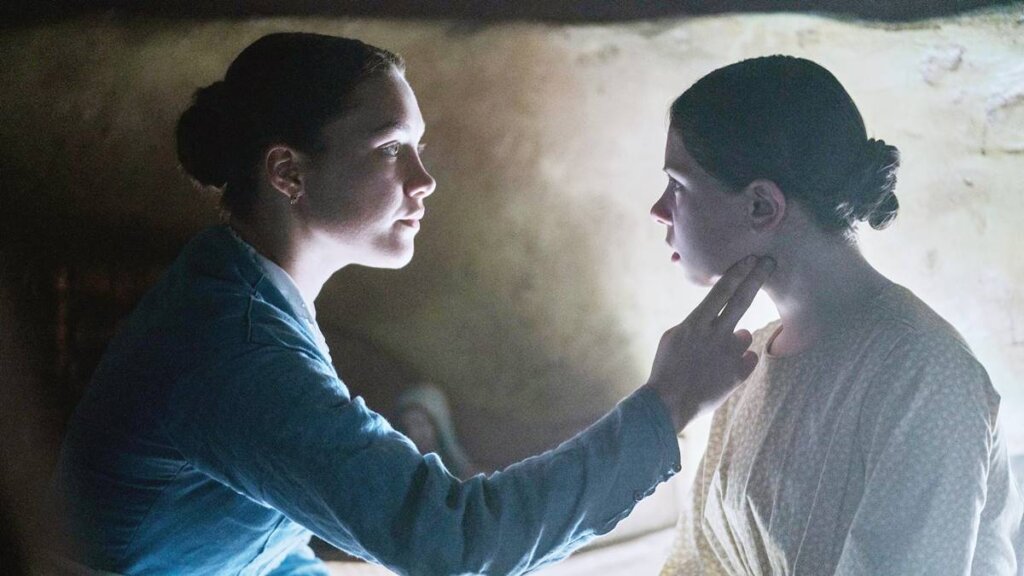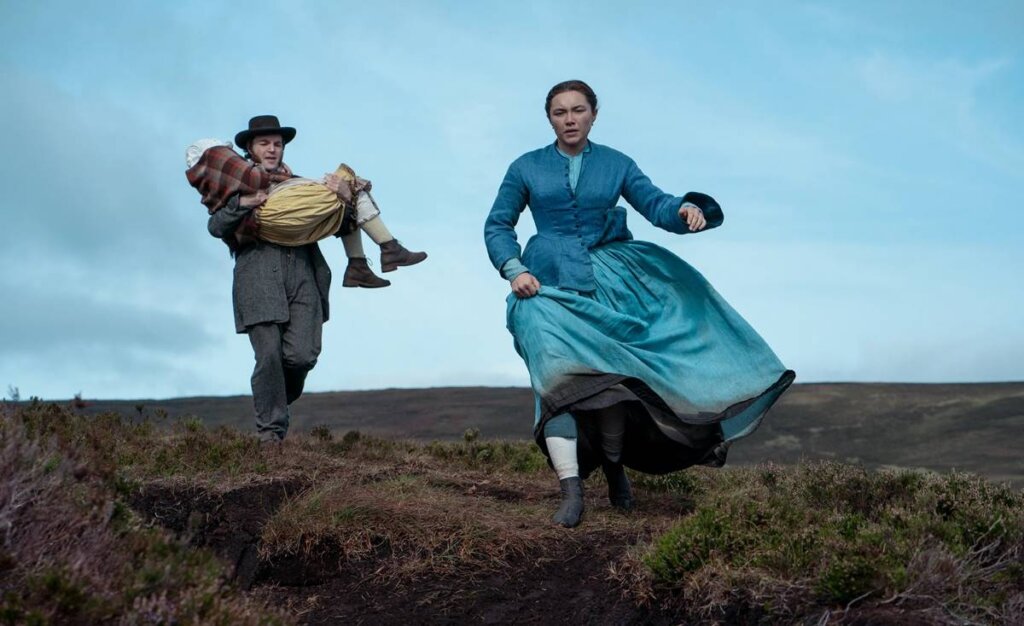The Wonder: The Eternal Debate Between Science and Religion


Written and verified by the psychologist Valeria Sabater
Anyone who believes that the Netflix movie, The Wonder, has the sole objective of simply telling a story of an event that took place in 1862 would be wrong. In fact, it’s the telling of one of those cyclical stories that contain the kinds of messages and concepts that are embedded in the essence of humanity. In this case, it’s the eternal confrontation between fanaticism and science, between faith and reason.
This production is directed by Sebastián Lelio and stars Florence Pugh. It relates the story of a nurse, Lib Wright, whose mission is to go to a small town in Ireland to observe a girl who, supposedly, hasn’t eaten for four months. Despite this permanent fast, the adolescent girl appears to be in good health.
The Wonder is based on the novel written by Emma Donoghue (The Wonder, 2016). While it’s true that neither the story nor the characters of Lib Wright and Anna O’Donnell actually existed, the phenomenon of the ‘fasting girls’ was a genuine fact and is well documented.
This movie is a metaphor for fervent fanaticism and includes an important message. It’s the fact that we live in a world in which, sometimes, the truth isn’t relevant or taken into account. All that matters is what each one of us wants to believe, even if this leads to conspiracy, fanaticism, and lies.
In the 19th century, there were many young women who, pushed by the closure of their faith, supposedly stopped eating. They were often seen by society as divine beings.

The Wonder and the history of the fasting women
The Wonder begins with an invitation. The viewer is guided from the present to a past scenario, with the director’s voice himself claiming that “We are nothing without stories”. He captures the essence of the movie that, as we’ve already pointed out, doesn’t only seek to bring us a unique experience that took place in 19th-century Ireland.
Every story is intended to invite reflection. For this reason, it’s necessary to see this film from a broader, more sensitive, and critical perspective. The viewer must walk, hand in hand, with nurse Lib Wright. Together with a nun, she has the responsibility of understanding how a girl is managing to survive without eating.
It’s also important to highlight the psychosocial scenario surrounding the young Anna O’Donnell. Her family, the townsfolk, the church, and even the doctors themselves view this phenomenon with admiration and devotion. They believe the girl is holy and feeds on manna from heaven. Therefore, there can be no other explanation than the divine. In the midst of this situation, Nurse Wright witnesses the little girl’s slow but inevitable physical decline.
The story of the fasting girls
Fasting girls existed. In fact, it was in this context that the term anorexia first appeared. Between 1810 and 1870, girls like Ann Moore and Sarah Jacob, driven by religious fanaticism, said they didn’t need food because they’d been chosen by God.
These girls became quite famous. People often visited them and left them gifts (sometimes large financial donations). However, it was obvious that families were feeding some of them when there were no witnesses around. Yet, there were other more dramatic cases. For instance, little Sarah Jacob ended up dying of starvation while a nurse watched and studied her.
The last cases were described at the end of the 19th century. This was when the scientific perspective began to prevail over religion and faith. Nevertheless, in certain regions of the more rural United Kingdom, the fasting women continued to attract acolytes and blind devotees who reaffirmed their truth. They continued to believe the idea of holy girls capable of going for years without eating thanks to the power of the divine. They continued to think they lived on manna from heaven.
The Wonder is a story about a hidden trauma and the use of religion and fanaticism to purge a supposed sin.

Fraud, fanaticism, and the fragility of the truth
We don’t want to reveal the interesting final intricacies of The Wonder. That said, we can point out that the production tells of psychological trauma and how religion acts as a punishment to purge what’s understood to be sin. The nurse, Lib Wright, is the figure in charge of challenging these dogmas and of bringing light to unreason.
However, when the protagonist finally uncovers the truth, no one wants to hear it. That’s because faith has more weight and fanaticism reigns. Indeed, nobody wants to break with the magical and miraculous that’s been established for years. It’s a place full of people who brand those who defend science as heretics. They even entrench themselves in their dogma to the point of letting an innocent girl die.
In the Ireland of the 19th century, there was no social media. That said, misinformation still spread like a virus, like a cloak of fog that obscured everything through absurd and conspiratorial arguments.
The truth, regardless of the time or the circumstance, is usually eternally violated and questioned under the most varied guises. Sometimes, it’s due to religion, at others, because of subtle interests, but it’s almost always down to ignorance.
Anyone who believes that the Netflix movie, The Wonder, has the sole objective of simply telling a story of an event that took place in 1862 would be wrong. In fact, it’s the telling of one of those cyclical stories that contain the kinds of messages and concepts that are embedded in the essence of humanity. In this case, it’s the eternal confrontation between fanaticism and science, between faith and reason.
This production is directed by Sebastián Lelio and stars Florence Pugh. It relates the story of a nurse, Lib Wright, whose mission is to go to a small town in Ireland to observe a girl who, supposedly, hasn’t eaten for four months. Despite this permanent fast, the adolescent girl appears to be in good health.
The Wonder is based on the novel written by Emma Donoghue (The Wonder, 2016). While it’s true that neither the story nor the characters of Lib Wright and Anna O’Donnell actually existed, the phenomenon of the ‘fasting girls’ was a genuine fact and is well documented.
This movie is a metaphor for fervent fanaticism and includes an important message. It’s the fact that we live in a world in which, sometimes, the truth isn’t relevant or taken into account. All that matters is what each one of us wants to believe, even if this leads to conspiracy, fanaticism, and lies.
In the 19th century, there were many young women who, pushed by the closure of their faith, supposedly stopped eating. They were often seen by society as divine beings.

The Wonder and the history of the fasting women
The Wonder begins with an invitation. The viewer is guided from the present to a past scenario, with the director’s voice himself claiming that “We are nothing without stories”. He captures the essence of the movie that, as we’ve already pointed out, doesn’t only seek to bring us a unique experience that took place in 19th-century Ireland.
Every story is intended to invite reflection. For this reason, it’s necessary to see this film from a broader, more sensitive, and critical perspective. The viewer must walk, hand in hand, with nurse Lib Wright. Together with a nun, she has the responsibility of understanding how a girl is managing to survive without eating.
It’s also important to highlight the psychosocial scenario surrounding the young Anna O’Donnell. Her family, the townsfolk, the church, and even the doctors themselves view this phenomenon with admiration and devotion. They believe the girl is holy and feeds on manna from heaven. Therefore, there can be no other explanation than the divine. In the midst of this situation, Nurse Wright witnesses the little girl’s slow but inevitable physical decline.
The story of the fasting girls
Fasting girls existed. In fact, it was in this context that the term anorexia first appeared. Between 1810 and 1870, girls like Ann Moore and Sarah Jacob, driven by religious fanaticism, said they didn’t need food because they’d been chosen by God.
These girls became quite famous. People often visited them and left them gifts (sometimes large financial donations). However, it was obvious that families were feeding some of them when there were no witnesses around. Yet, there were other more dramatic cases. For instance, little Sarah Jacob ended up dying of starvation while a nurse watched and studied her.
The last cases were described at the end of the 19th century. This was when the scientific perspective began to prevail over religion and faith. Nevertheless, in certain regions of the more rural United Kingdom, the fasting women continued to attract acolytes and blind devotees who reaffirmed their truth. They continued to believe the idea of holy girls capable of going for years without eating thanks to the power of the divine. They continued to think they lived on manna from heaven.
The Wonder is a story about a hidden trauma and the use of religion and fanaticism to purge a supposed sin.

Fraud, fanaticism, and the fragility of the truth
We don’t want to reveal the interesting final intricacies of The Wonder. That said, we can point out that the production tells of psychological trauma and how religion acts as a punishment to purge what’s understood to be sin. The nurse, Lib Wright, is the figure in charge of challenging these dogmas and of bringing light to unreason.
However, when the protagonist finally uncovers the truth, no one wants to hear it. That’s because faith has more weight and fanaticism reigns. Indeed, nobody wants to break with the magical and miraculous that’s been established for years. It’s a place full of people who brand those who defend science as heretics. They even entrench themselves in their dogma to the point of letting an innocent girl die.
In the Ireland of the 19th century, there was no social media. That said, misinformation still spread like a virus, like a cloak of fog that obscured everything through absurd and conspiratorial arguments.
The truth, regardless of the time or the circumstance, is usually eternally violated and questioned under the most varied guises. Sometimes, it’s due to religion, at others, because of subtle interests, but it’s almost always down to ignorance.
All cited sources were thoroughly reviewed by our team to ensure their quality, reliability, currency, and validity. The bibliography of this article was considered reliable and of academic or scientific accuracy.
- Breslau, N., Wilcox, HC, Storr, CL, Lucía, VC y Anthony, JC (2004). Exposición al trauma y trastorno de estrés postraumático: un estudio de jóvenes en las zonas urbanas de Estados Unidos. Revista de salud urbana: boletín de la Academia de Medicina de Nueva York , 81 (4), 530–544. https://doi.org/10.1093/jurban/jth138.
This text is provided for informational purposes only and does not replace consultation with a professional. If in doubt, consult your specialist.







